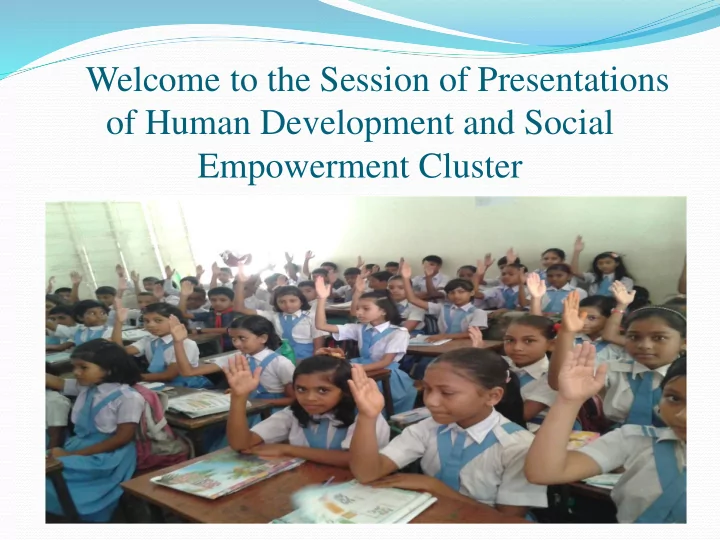

Welcome to the Session of Presentations of Human Development and Social Empowerment Cluster
Vision: The vision of the cluster is to enhance human development and facilitate social empowerment of disadvantaged people. Mission: The mission of the cluster is to coordinate with the line ministries to enhance education and training for children and young people, and ensure social justice by ensuring rights of the poor especially, women and children by inclusion efforts.
Presentation on Contribution of the Ministry of Primary and Mass Education to the National Social Security Strategy
Major Projects for Social Protection Under MoPME Primary Education Stipend Project (Phase-III) 1. Reaching Out of School Children (Phase-II) 2. School Feeding Project in Poverty Prone Area 3. 4. Basic Literacy Project (64 Distrcts)
Primary Education Stipend Project (PESP) (Phase-III) Stipend Project for Primary Education started in 1999. PESP-I continued up-to June 2008 PESP-II (July 2008-June 2015), Beneficiaries were: 7870129, Cost TK. 568726.07 lakh PESP-III (July 2015- Dec’ 19), Beneficiaries: 1.30 crore (DPP Target 1.40 crore), Yearly cost: BDT 1500 crore (approximately) Stipend distributed to student’s mother (generally)/ guardian through Mobile Banking. PESP is one of the biggest projects for stipend for education, massive initiatives for digitalization as well as women empowerment in Bangladesh.
Monthly Stipend Rate (Children from a family) Class 1 Child 2 Children 3 Children 4 Children Remarks Pre-primary 50 Each child gets Tk 50 I 100 200 250 300 II 100 200 250 300 III 100 200 250 300 IV 100 200 250 300 V 100 200 250 300 VI-VIII 125 250 350 400
Reaching Out of School Children (ROSC) Project, Phase-II ROSC (Phase-II, Jan 2013-Dec 2020) Number of Ananda Schools (LCs): 7139 (in 120 upazilas under 48 districts) Students in Learning Centers: 139715 In 10 city corporations: 1647 LCs under 350 compounds with 44184 students. 22 vocational courses run for 15-22 year ages learners. Already 8046 learners completed the course. 25000 trainees (from ROSC Phase-1) of 90 upazila will be given vocational training.
Vocational Training by ROSC During vocation training, a trainee gets taka 100 per day and taka 800 after finishing the course. Experienced trainers used modern equipments for training. Vocational Training period: 3 months (360 hours) The project helps & supports for job placement after finishing the vocational course.
School Feeding Program in Poverty Prone Areas Duration: July 2010-December 2020 3 rd RDPP Estimated Cost: BDT. In Lakh 499197.29 (GOB: 373706.82, PA: 125490.47) Number of upazila: 104 (GOB-94 & WFP-10) Schools: 15289 (GOB-13482, WFP-1807) Targeted number of students: 32.31 lakh
Information of Students (Beneficiaries) (Last 6 years) Year Upazila Schools Students Remarks 2013 81 12424 2681121 2014 81 12987 2711043 2015 93 14715 2825710 2016 93 15714 3005409 2017 93 14888 2875315 2018 104 15080 2942874
Basic Literacy Project (64 Districts) Objectives of Project: ❖ To provide Basic Literacy and Life skills to 4.5 million illiterate adolescents and adults of 15-45 age groups. ❖ To contribute in eradication of illiteracy from the country as well as achieving the 7th Five year Plan. ❖ To contribute in the Implementation of the National NFE Policy and the National Education Policy -2010. ❖ To promote GO-NGO and community collaboration in NFE. ❖ To develop primers in the mother tongue(s) of the ethnic groups for the learners of 3 hill districts.
Main Activities of the Project ❖ Each center will have separate shift for male and female learners. ❖ Establishment and operation of total 75,000 Learning Centers. ❖ Enlistment of 45 lakh ( 4.5 million) learners of 15-45 age group . ❖ Engagement of total 150,000 teachers. ❖ Each learning center have one male and one female teacher. ❖ Engagement of total 37,500 supervisors. ❖ Basic Literacy Course Duration : 06 months in each phase. ❖ Number of phase for the project : 04 phases. ❖ 60 learners per center- 30 male+ 30 female)
Out put of the project ➢ Created opportunities of job-placement for at least one person of each family ➢ Reduced illiteracy rate in the country. ➢ Increased awareness of learners about health environment and social issues. ➢ Improved lifestyle of target groups which turned them to become enlightened & productive citizen. ➢ The project created opportunity of literacy for the disadvantaged people living in Char, Hawor, Hills and geographically remote areas.
Challenges ❖ The project has to be linked with skills development training for the literacy course graduates. ❖ Absence of permanent NFE setup of BNFE at Upazila ❖ Budget of the project needs to be revised for successful implementation. ❖ Increased incentives package for the Teachers, Supervisors and Trainers for motivation.
Scale-up Plan To achieve the targets of the Vision 2021-41, Sustainable Development Goals (by 2030) as well as the 7 th Five Year Plan (2016-20), BNFE has developed a Sector Wide Approach Program “ Non-Formal Education Development Program (NFEDP). The specific objectives of NFEDP are to: Provide literacy to 5 million illiterate youth & adults of 15 years and above Provide skills development training to 1.5 million neo-literate/semi-literate Provide second chance opportunity for 1 million out of school children (age 8 to 14) Ensure lifelong learning opportunities for approximately 5 million Literacy and Skills training course graduates and community people through establishing Learning Centers (CLCs) at 4554 unions and 471 urban settings Establish 2000 ICT based permanent Community Learning Centers at 2000 unions and 64 Livelihood Training Centers at 64 districts. Strengthen capacity & restructure of BNFE to ensure effective NFE program.
Inauguration of Textbook distribution (Free of cost) by Hon’ble Prime Minister
School Feeding program
Mid day meal at school
Stipend through Mobile Banking
Vocational Training Class run by ROSC
Achievements of ROSC Students
Basic Literacy Project (64 Districts)
Training for Supervisors (BLP)
THANKS
Recommend
More recommend